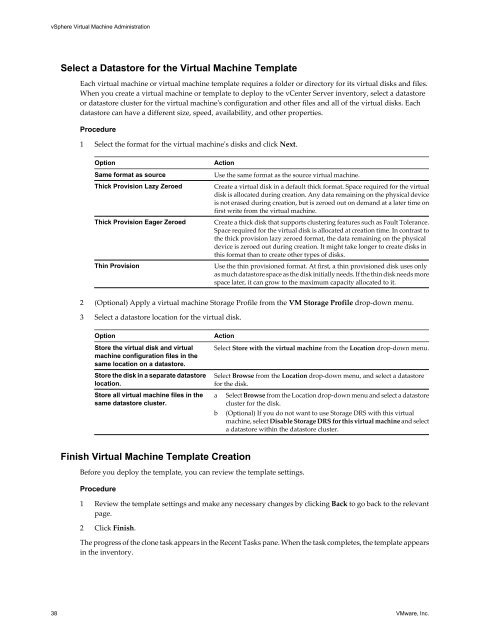vSphere Virtual Machine Administration - Documentation - VMware
vSphere Virtual Machine Administration - Documentation - VMware
vSphere Virtual Machine Administration - Documentation - VMware
You also want an ePaper? Increase the reach of your titles
YUMPU automatically turns print PDFs into web optimized ePapers that Google loves.
<strong>vSphere</strong> <strong>Virtual</strong> <strong>Machine</strong> <strong>Administration</strong><br />
Select a Datastore for the <strong>Virtual</strong> <strong>Machine</strong> Template<br />
Each virtual machine or virtual machine template requires a folder or directory for its virtual disks and files.<br />
When you create a virtual machine or template to deploy to the vCenter Server inventory, select a datastore<br />
or datastore cluster for the virtual machine's configuration and other files and all of the virtual disks. Each<br />
datastore can have a different size, speed, availability, and other properties.<br />
Procedure<br />
1 Select the format for the virtual machine's disks and click Next.<br />
Option Action<br />
Same format as source Use the same format as the source virtual machine.<br />
Thick Provision Lazy Zeroed Create a virtual disk in a default thick format. Space required for the virtual<br />
disk is allocated during creation. Any data remaining on the physical device<br />
is not erased during creation, but is zeroed out on demand at a later time on<br />
first write from the virtual machine.<br />
Thick Provision Eager Zeroed Create a thick disk that supports clustering features such as Fault Tolerance.<br />
Space required for the virtual disk is allocated at creation time. In contrast to<br />
the thick provision lazy zeroed format, the data remaining on the physical<br />
device is zeroed out during creation. It might take longer to create disks in<br />
this format than to create other types of disks.<br />
Thin Provision Use the thin provisioned format. At first, a thin provisioned disk uses only<br />
as much datastore space as the disk initially needs. If the thin disk needs more<br />
space later, it can grow to the maximum capacity allocated to it.<br />
2 (Optional) Apply a virtual machine Storage Profile from the VM Storage Profile drop-down menu.<br />
3 Select a datastore location for the virtual disk.<br />
Option Action<br />
Store the virtual disk and virtual<br />
machine configuration files in the<br />
same location on a datastore.<br />
Store the disk in a separate datastore<br />
location.<br />
Store all virtual machine files in the<br />
same datastore cluster.<br />
Finish <strong>Virtual</strong> <strong>Machine</strong> Template Creation<br />
Before you deploy the template, you can review the template settings.<br />
Procedure<br />
Select Store with the virtual machine from the Location drop-down menu.<br />
Select Browse from the Location drop-down menu, and select a datastore<br />
for the disk.<br />
a Select Browse from the Location drop-down menu and select a datastore<br />
cluster for the disk.<br />
b (Optional) If you do not want to use Storage DRS with this virtual<br />
machine, select Disable Storage DRS for this virtual machine and select<br />
a datastore within the datastore cluster.<br />
1 Review the template settings and make any necessary changes by clicking Back to go back to the relevant<br />
page.<br />
2 Click Finish.<br />
The progress of the clone task appears in the Recent Tasks pane. When the task completes, the template appears<br />
in the inventory.<br />
38 <strong>VMware</strong>, Inc.
















